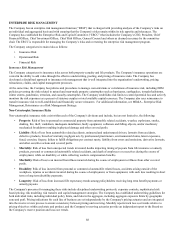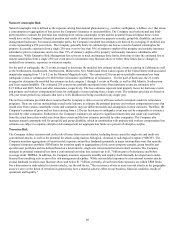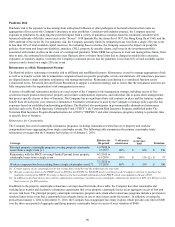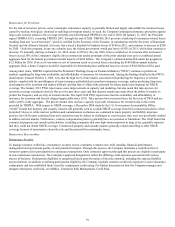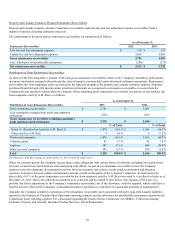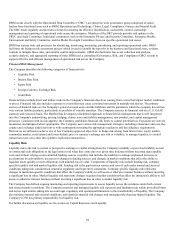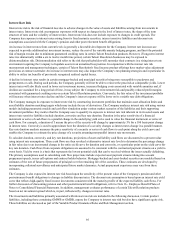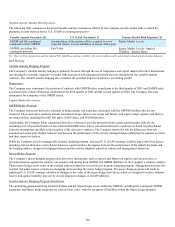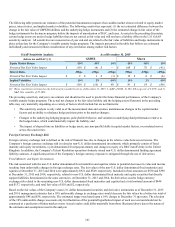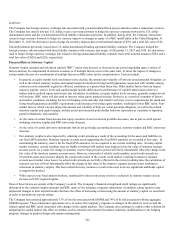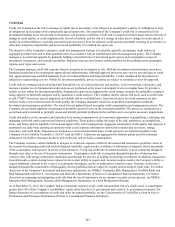The Hartford 2015 Annual Report Download - page 98
Download and view the complete annual report
Please find page 98 of the 2015 The Hartford annual report below. You can navigate through the pages in the report by either clicking on the pages listed below, or by using the keyword search tool below to find specific information within the annual report.98
The Company's exposure to equity risk includes the potential for lower earnings associated with certain businesses such as mutual funds
and variable annuities where fee income is earned based upon the value of the assets under management. For further discussion of equity
risk, see the Variable Product Guarantee Risks and Risk Management section below. In addition, Talcott Resolution includes certain
guaranteed benefits, primarily associated with variable annuity products, which increase the Company's potential benefit exposure in the
periods that equity markets decline.
The Company is also subject to equity risk based upon the assets that support its pension and other post retirement benefit plans. The
asset allocation mix is reviewed on a periodic basis. In order to minimize risk, the pension plans maintain a listing of permissible and
prohibited investments. In addition, the pension plans have certain concentration limits and investment quality requirements imposed on
permissible investment options. For further discussion of equity risk associated with the pension plans, see the Critical Accounting
Estimates section of the MD&A under “Pension and Other Postretirement Benefit Obligations” and Note 16 Employee Benefit Plans of
Notes to Consolidated Financial Statements.
Variable Product Guarantee Risks and Risk Management
The Company’s variable products are significantly influenced by the U.S. and other equity markets. Increases or declines in equity
markets impact certain assets and liabilities related to the Company’s variable products and the Company’s earnings derived from those
products. The Company’s variable products include variable annuity contracts and mutual funds.
Generally, declines in equity markets will:
• reduce the value of assets under management and the amount of fee income generated from those assets;
• increase the liability for GMWB benefits resulting in realized capital losses;
• increase the value of derivative assets used to hedge product guarantees resulting in realized capital gains;
• increase the costs of the hedging instruments we use in our hedging program;
• increase the Company’s net amount at risk ("NAR") for GMDB and GMWB benefits;
• increase the amount of required assets to be held backing variable annuity guarantees to maintain required regulatory reserve
levels and targeted risk based capital ratios; and
• decrease the Company’s estimated future gross profits, resulting in a DAC unlock charge. See Estimated Gross Profits Used in
the Valuation and Amortization of Assets and Liabilities Associated with Variable Annuity Contracts within the Critical
Accounting Estimates section of the MD&A for further information.
Generally, increases in equity markets will have the inverse impact of those listed in the preceding discussion. For additional
information, see Risk Hedging - Variable Annuity Hedging Program section.
Variable Annuity Guaranteed Benefits
The Company’s variable annuities include GMDB and certain contracts with GMDB also include GMWB features. Declines in the
equity markets will increase the Company’s liability for these benefits. Many contracts with a GMDB include a maximum anniversary
value ("MAV"), which in rising markets resets the guarantee on anniversary to be 'at the money'. As the MAV increases, it can increase
the NAR for subsequent declines in account value. Generally, a GMWB contract is ‘in the money’ if the contractholder’s guaranteed
remaining balance ("GRB") becomes greater than the account value.
The NAR is generally defined as the guaranteed minimum benefit amount in excess of the contractholder’s current account value.
Variable annuity account values with guarantee features were $44.2 billion and $52.9 billion as of December 31, 2015 and December 31,
2014, respectively.


